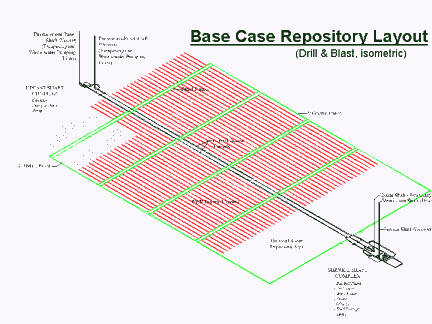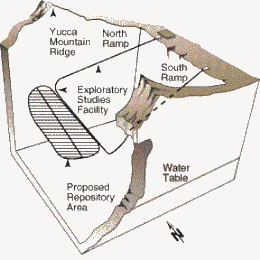|
The
repository layout builds on the information and key geologic
constraints which define emplacement tunnel dimensions and
borehole separation distances, borehole layouts and waste-receipt
schedules. The basic design concept for the repository consists
of various underground openings including the disposal area
of spent fuels and expansion area, the service shaft complex
and the ventilation exhaust shaft complex.
SATURATED
ROCK

(Courtesy of KAERI-HLW Geological Disposal
System Development Department)
The
design concept for the saturated rock is based on the deposition
of the HLW canister in the vertical hole. Prior to the receipt
of the container, the compacted bentonite buffer is placed
in the deposition hole. After container emplacement, the gap
between the container and the buffer is filled with bentonite
powder. The emplacement tunnel will not be backfilled during
the operational period of 50 years for monitored storage.
After the designed monitored-storage operation, all access
and deposition tunnels will be backfilled with a mixture of
crushed rock and bentonite and a concrete bulkhead will be
constructed at the tunnel entrance to complete sealing for
repository closure.
The base
case repository for the saturated rock may include backfilling,
particularly of the emplacement tunnels, immediately after
waste emplacement or 50 to 100-years following the monitored
storage period. Because the backfilling is intended to provide
additional support for the closure of underground openings,
the backfill timing and method are important parameters from
the aspect of disposal safety, cost and political issues (e.g.
retrieval for reuse or change of safety constraints). The
backfill composition should be determined through more detailed
performance assessments and engineering trade-off studies.
UNSATURATED
ROCK

The basic
design concept for the unsaturated rock comes from the U.S.
HLW project (Yucca Mt.). The canisters of spent fuels will
be placed in horizontal emplacement drifts without buffer
materials. A high thermal load generated from the HLW will
drive the moisture in the rock away from the canisters. However,
once the repository cools down, water vapor condenses. The
engineered barriers, including double layered canister, invert
in the floors, and drip shields, will prevent the waste package
from dripping water.
Yucca
Mountain Science and Engineering Report describes the
following design concepts based on two different operating
temperature modes.
For
the higher-temperature operating mode, the packages would
be spaced about 10 cm (4 in.) apart. The base design includes
58 horizontal emplacement drifts excavated to a 5.5-m (18-ft)
diameter at a center-to-center drift spacing of 81 m (266
ft). The total subsurface area required to accommodate 70,000
MTHM is about 1,150 acres. For the lower-temperature operating
mode, a larger area (up to about 2,500 acres) may be required.
In the present design, the underground facility would be constructed
over a period of about 23 years.
|